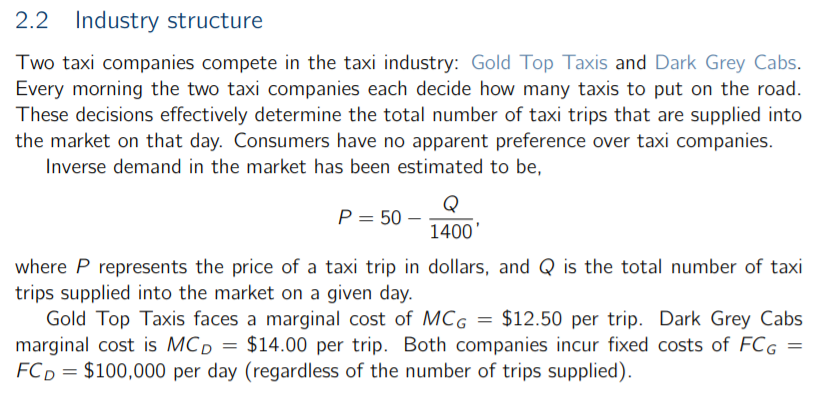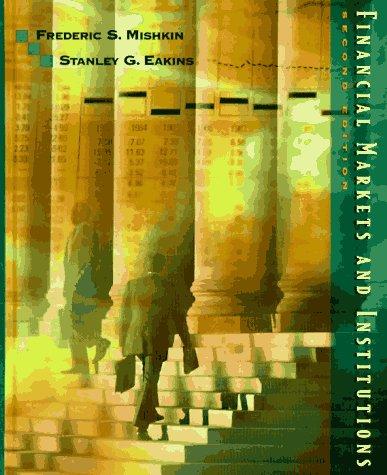Question
When completing the industry analysis you should assume that firms are engaged in Cournot Competition. Use the subscript G to denote variables belonging to Gold


When completing the industry analysis you should assume that firms are engaged in Cournot Competition. Use the subscript G to denote variables belonging to Gold Top Taxis, and the subscript D to denote variables belonging to Dark Grey Cabs.
Step 1: Derive the two firms total cost functions for the case in which there is a $2.40 tax per trip is imposed on the taxi industry.
Step 2: Derive the two firms profit functions for the case in which there is $2.40 tax per trip imposed on the taxi industry.
Step 3: Derive the two firms best response functions for the case in which there is a $2.40 tax per trip imposed on the taxi industry.
Step 4: Derive the long-run equilibrium firm quantities, market price, firm profits, and consumer surplus, for the case in which there is a $2.40 tax per trip imposed on the taxi industry.
Step 5: Derive the long-run equilibrium firm quantities, market price, firm profits, and consumer surplus, for the case in which a $50,000 per day tax is imposed on the taxi industry.
Hi can you please answer the following steps showing all working out and formulas used. Also if you can please type the answer out as well and not copy the answers off of already asked questions.
2 Scenario The government is about to undertake a large program of public works, repairing and upgrading bridges around the city. The Department of Economic Development, Jobs, Transport and Resources has decided that the public works will be funded, in part, by a new tax on taxi companies. The government's rationale for the new tax is that taxi operators benefit from well maintained roads and bridges, and therefore should contribute to their upkeep. The Department has developed two alternative proposals for the new taxi industry tax: 1. The first proposal is to levy a tax of $2.40 per taxi trip. (Note: This tax would increase each company's marginal cost by $2.40.) 2. The second proposal is to levy a lump-sum tax of $50,000 per day, on each taxi company, regardless of the number of taxi trips it provides to consumers. (Note: This tax would increase each company's marginal cost by $50,000.) Taxi companies oppose both proposals. In a submission to the Department, the companies claim that a new tax will not have the intended effect. The companies state that they will have no choice but to pass the cost of a new tax on to consumers, in the form of higher prices, and that consequently the burden of the tax will fall on their customers, not the companies themselves. 2.2 Industry structure Two taxi companies compete in the taxi industry: Gold Top Taxis and Dark Grey Cabs. Every morning the two taxi companies each decide how many taxis to put on the road. These decisions effectively determine the total number of taxi trips that are supplied into the market on that day. Consumers have no apparent preference over taxi companies. Inverse demand in the market has been estimated to be, Q P = 50 1400' where P represents the price of a taxi trip in dollars, and Q is the total number of taxi trips supplied into the market on a given day. Gold Top Taxis faces a marginal cost of MCG = $12.50 per trip. Dark Grey Cabs marginal cost is MCD = $14.00 per trip. Both companies incur fixed costs of FCG = FCD = $100,000 per day (regardless of the number of trips supplied)Step by Step Solution
There are 3 Steps involved in it
Step: 1

Get Instant Access to Expert-Tailored Solutions
See step-by-step solutions with expert insights and AI powered tools for academic success
Step: 2

Step: 3

Ace Your Homework with AI
Get the answers you need in no time with our AI-driven, step-by-step assistance
Get Started


